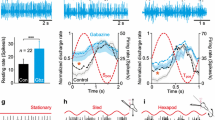Abstract
Intact pigeons (n=64) were rotated in the dark in the horizontal plane at different orientations relative to the axis of rotation. The overall patterns of changes in nystagmus of the eyes arising as a result of displacement of the otolith membranes in several directions were analyzed. In ten pigeons, all changes in nystagmus (type 1 general patterns) could be explained in terms of the dynamics of peripheral neuron activity and non-specific (identical for all combinations of interacting inputs) central influences. In the remaining pigeons, part of the changes in nystagmus (type 2 general patterns) was associated with central influences which were not identical for different combinations of interacting inputs. Repeated unusual combinations of vestibular stimuli and subsequent treatment with Nembutal transformed type 2 general patterns into type 1 general patterns. These data provide evidence for the fragmentary control of eye movements, whereby there is selective (fragmentary) modification of only some (individually specific) combinations of canal and otolith signals out of the whole set of vestibuloocular responses arising in response to stimulation of paired vestibular inputs; modification is mediated by changes in the sign of otolith influences on the canal components of these responses.
Similar content being viewed by others
References
Yu. K. Stolbkov, “Channel-otolith interactions in conditions of otolith asymmetry,”Fiziol. Zh. SSSR,75, No. 10, 1381–1388 (1989).
Yu. K. Stolbkov, “Interlabyrinth otolith symmetry and asymmetry as factors in channel-otolith relationships,”Fiziol. Zh. SSSR,76, No. 2, 152–159 (1990).
Yu. K. Stolbkov, “Vestibular nystagmus as a result of the interaction of the channel and otolith subsystems of the vestibular systems,”Kosmich. Biol. Aviakosmich. Med.,25, No. 3, 28–31 (1991).
Yu. K. Stolbkov, I. V. Orlov, and V. S. Stabanov, “The interaction of the vestibular inputs with the otoliths in different orientations in the gravitational field,”Ros. Fiziol. Zh. im. I. M. Sechenova,80, No. 8, 48–56 (1994).
Yu. K. Stolbkov and I. V. Orlov, “Mechanisms of interaction of the angular and linear components of the horizontal vestibular-ocular reflex in the pigeon,”Ros. Fiziol. Zh. im. I. M. Sechenova,84, No. 11, 1252–1263 (1998).
K. L. Khilov,The Functions of the Balance Organs and Locomotor Diseases [in Russian], Meditsina, Moscow (1969).
D. Anastapoulos, C. Gianna, A. M. Bronstein, and M. A. Gresty, “Otolith-ocular and angular horizontal vestibulo-ocular reflex in darkness,”Ann. N.Y. Acad Sci.,781, 580–582 (1996).
M. J. Correia, J. P. Landolt, R. P. S. Cardin, et al., “Techniques for prolonged single unit recording and data analysis of discharges from primary neurons in the pigeon's vestibular region,”DCIEM Report N297, Defence and Civil Institute of Environmental Medicine, Defence Research Board, Canada (1973).
B. Crane, E. Viirre, and J. Demer, The human vestibuloocular reflex during combined linear and angular acceleration,”Exp. Brain Res.,114, 304–320 (1997).
J. Demer, J. Goldberg, H. Jenkins, and F. Porter, “Vestibulo-ocular reflex during magnified vision: adaptation to reduce visual-vestibular conflict,”Aviat. Space Environ. Med.,58, Supplement, A175–179 (1987).
C. Fernández and J. M. Goldberg, “Physiology of peripheral neurons innervating otolith organs of the squirrel monkey. 1. Response to static tilts and to long-duration centrifugal force,”J. Neurophysiol.,39, 970–984 (1976).
J. M. Goldberg and C. Fernández, “Physiology of peripheral neurons innervating semicircular canals of the squirrel monkey. 1. Resting discharge and response to constant angular accelerations,”J. Neurophysiol.,34, 635–660 (1971).
A. Gonshor and G. Melvill Jones, “Extreme vistibulo-ocular adaptation induced by prolonged optical reversal of vision,”J. Physiol. (London),256, 381–414 (1976).
M. Gresty, A. Bronstein, and H. Barrat, “Eye movement responses to combined linear and angular head movement,”Exp. Brain Res.,65, 377–384 (1987).
M. Ito,The Cerebellum and Neural Control, Raven Press, New York (1984).
L. N. Kornilova, “Vestibular function and sensory interaction in altered gravity,”Adv. Space Biol. Med.,6, 275–313 (1997).
T. Lempert, C. Gianna, G. Brookes, A. Bronstein, and M. Gresty, “The mid-lateral region of the utricle generates the human transaural linear vestibulo-ocular reflex,”Ann. N.Y. Acad. Sci.,781, 647–649 (1996).
M. Merfeld and L. Young, “The vestibulo-ocular reflex of the squirrel monkey during eccentric rotation and roll titt,”Exp. Brain Res.,106, 111–122 (1995).
T. Raphan, E. Wearne, and B. Cohen, “Modeling the organization of the linear and angular vestibulo-ocular reflexes,”Ann. N.Y. Acad. Sci.,781, 348–363 (1996).
I. Sargent and G. Paige, “The primate vestibulo-ocular reflex during combined linear and angular head motion,”Exp. Brain Res.,87, 75–84 (1991).
Author information
Authors and Affiliations
Additional information
Translated from Rossiiskii Fiziologicheskii Zhurnal imeni I. M. Sechenova, Vol. 84, No. 12, pp. 1350–1362, October, 1998.
Rights and permissions
About this article
Cite this article
Stolbkov, Y.K., Orlov, I.V. Fragmentary control of vestibuloocular responses. Neurosci Behav Physiol 30, 213–223 (2000). https://doi.org/10.1007/BF02463161
Received:
Revised:
Issue Date:
DOI: https://doi.org/10.1007/BF02463161




